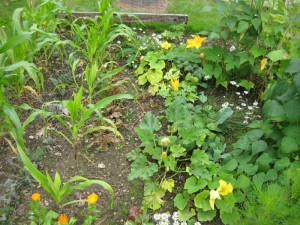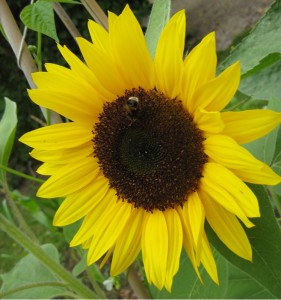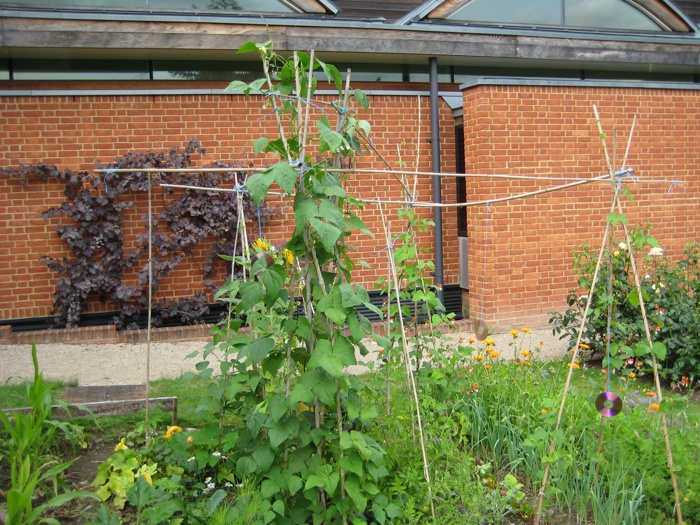At the Allotment Plot at MERL on 19 August 2010 it was noted that some of the plants look a little yellow, particularly the Sweet Corn, Squashes and Tomatoes, this could be that they have been under watered or over watered, the former seems more likely than the latter. The plants have not been lacking sunlight so chlorophyll molecules photosynthesis work that give plants their green colour should not have been impeded. Although it had rained during the night, the soil looked fairly dry. The first row of Lettuce Marvel of the Four Seasons had finished producing and roots were extracted from the ground then left to decompose in to the soil. Meanwhile the Sunflowers glow radiated the cloudy day.


Ella Montt was preparing to film part of the Plot when two visitors came into the garden to sit at a bench nearby so that they could eat lunch and converse. The Museum’s garden is a public space. Ella Montt, at this moment, did not want to record private conversation, so worked on other areas of the Plot before sitting to consume lunch and then resumed the quest to film the Plot once the visitors were gone. Part of the Plot on that day, was to plant some green manure in any spaces available. The chosen green manure seeds from Tamar Organics was Fenugreek, it is quick growing and should be ready in to dig in ten weeks time, around mid October. The plant is a legume. The aromatic seeds and leaves of Fenugreek are both used extensively in cooking, particularly in curries.
A small green Squash is growing, the other Squash plants are still lacking in female flowers. A first harvest of Spring Onions White Lisbon became part of the day’s action. The Pot Marigold continue to flower producing quantities of seeds, those that had darkened and dried were harvested into an empty seed packet for distribution at a later stage. Thoughts turn to scattering the seeds in Guerrilla Gardening format or seed swaps. The Marigolds will perhaps self-seed as has both the Borage and Chamomile. Harvesting of other crops commenced with Herbs, Basil, Mint, Marjoram, and Chives. Harvesting of other crops commenced with Herbs, Basil, Mint, Marjoram, and Chives; followed by Rainbow Chard = 2oz = 60grams, Kale Pentland Brig = 3oz = 80grams, Tomatoes = 11oz = 320grams, French Climbing Beans ~ Blauhide 2oz = 60grams = and Blue Lake = 6oz = 20grams, and 1 Runner Bean = 1oz = 20grams.
Ella Montt has been considering the growth of the Climbing Beans up the four supporting bamboo pyramid structures. Some of the plants have climbed past the pyramid structures and are searching the sky for support. More bamboo canes were hunted out and collected from the shed across the garden then delivered to the Plot. Ella Montt attached the bamboo horizontally from one pyramid to the next; all of the pyramids are now linked at their zeniths so that the climbing and runner beans can continue to grow to optimize their plant constructions. Ella Montt wishes to enhance the Beans growth potential to compensate for Brassica failure. In any given season the harvest that a crop will produce can be unpredictable at the outset, because of weather conditions, disease, predators and unforeseen chance happenings, Ella Montt has to adopt a flexible working strategy to maintain the balance of available produce.
